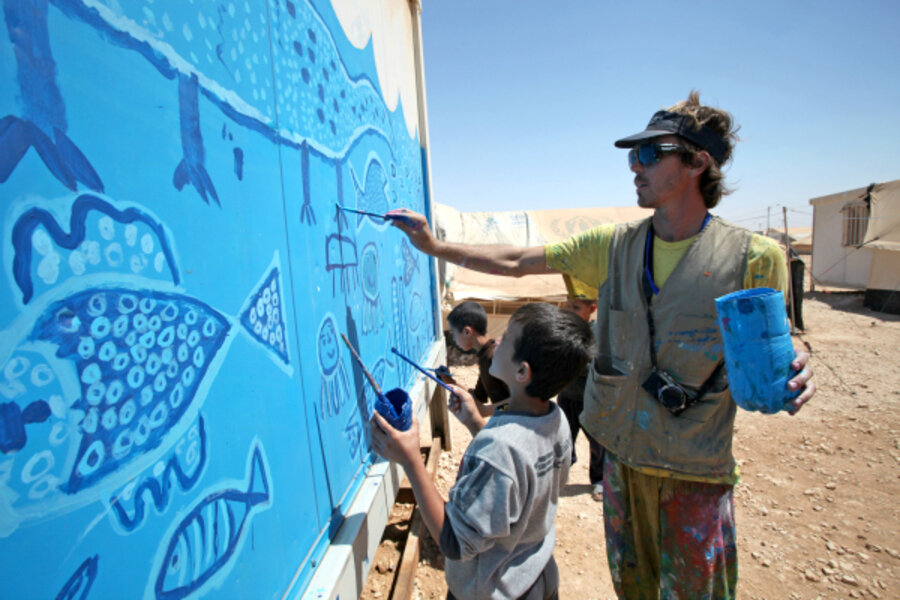US artist, Syrian children beautify a refugee camp
Loading...
| Zaatari, Jordan
Young Syrian children, refugees of their country's grinding civil war, playfully grab paint brushes and rollers nearly as big as they are in this windswept desert camp, adding splashes of bright color to their bleak surroundings.
Most of the trailers and tents match the beige color of the swirling sand surrounding the Zaatari refugee camp, home to about 120,000 Syrians who fled the nearly three-year war still gripping the nation. Slowly though, that's changing with the help of a US artist who is leading children haunted by the conflict to paint buildings and walls at the crowded camp with murals expressing their lives and hopes.
"So many children are bored in Zaatari. They just throw rocks because they have nothing else to do," artist Samantha Robison said. "There's a lot of violent tendencies and negative energy, so if you bring in art and give them a positive activity, it helps a lot."
The painting project gives a moment of color and self-expression for kids who have had their lives shattered by Syria's war. Last week, the special UN envoy for children and conflict warned about the effects of the upheaval on children, warning that Syria's violence is producing a generation plagued with illiteracy and "filled with hate."
Just over half the refugees in Zaatari are under the age of 18. On what was once an empty patch of desert, the sprawling complex has grown in just a year into the second- largest refugee camp in the world and is Jordan's fifth-largest populated city, with more refugees pouring daily across the border, just 16 kilometers (10 miles) away. Many of the families come from the southern Syrian province of Daraa, where the Syrian uprising began, and many of the children have directly experienced the trauma of having their neighborhoods bombarded and having relatives killed.
Ms. Robison,from the Washington, D.C.-area, works in the camp as part of an organization she founded called AptART. She has traveled to Cambodia, Congo, Iraq, and Syria to work on art projects before arriving at Zaatari.
Under Robison's watch, children have already painted a number of structures. A one-time white trailer serving as a pediatric clinic now sports a bright blue facade, with cartoon images of doctors, children, and parents appearing in bold orange, turquoise, and red tones. Big Arabic calligraphy appears throughout, offering the adage: "Prevention is better than cure."
In another part of the camp, a giant purple tree spreads its branches over the length of a wall at one of Zaatari's schools. Among the branches, refugee children painted a plane, an easel, and other symbols — objects representing jobs they hope to have when they grow up.
As South African artist Luc Van Der Walt, one of those working with Robison, poured out the paint into large canisters to mix, the children — from as young as 5 years old to their early teens — crowded around, anxious to dip their brushes. Tiny girls squealed as they dashed to the nearby wall to dab it with flashes of bright yellow. "Slow down, slow down," Syrian volunteers repeatedly told the excited children, trying to get them to take turns at the paint bucket.
A 12-year-old girl, who gave her name as Habeer, sang while she and the kids painted a mural.
"I am happy when I am painting," she said. "I try to draw a lot at school. The best things I like to draw are trees, birds, and flowers. I want to be a teacher when I grow up."
Robison, who works with Mr. Van Der Walt, said the artwork helps children take a sense of ownership in the crowded refugee camp, where some have dismantled structures for their own use. Particularly hard hit are communal bathrooms, as refugees take apart the bricks and piping to construct their own private showers and toilets, aid workers say.
"We allow children to write on a wall. We turn writing on a wall into a positive thing," Robison said. "What child hasn't written their name or something and was scolded? We're having a little bit of fun with it and getting the kids involved."
Robison stops children from painting the black, white, and green tricolor flag of Syria's opposition, trying to keep politics out of the work. She and Van Der Walt also stop children from copying cartoon characters from television, though they encourage any other artistic endeavor.
Around 600 children in the camp have participated in the program so far, as the artist team moves from section to section of the camp, Robison said. The kids lay down a base coat and then add their pictures, then Robison and her colleagues incorporate it into a larger mural. Often the murals have a public service message, like to beware of germs or to avoid wasting water.
Children laugh and sing as they paint. Some plant paint handprints on the walls.
Rawan, a 10-year-old, was helping give a bathroom wall a bright coat of yellow paint.
"I've painted many buildings in Zaatari," she said. "I like painting and putting designs on everything, including trailers and now this washroom."
Robin Nataf, part of another aid group called ACTED, said the art helped bring refugees together.
"As soon as AptART take out the paint, children, elders, even imams and schoolteachers turn out. Everybody is happy to see some fun happening and the children getting involved," Nataf said.
"These people have to live here, and we don't know for how long. It's important they make it as nice as possible."
• To learn more, visit www.aptart.org





